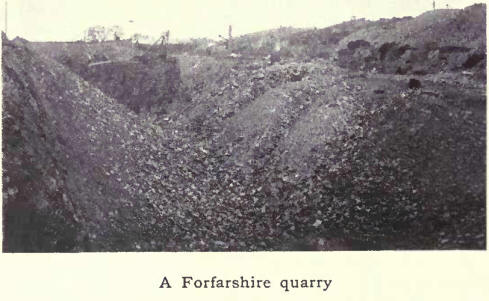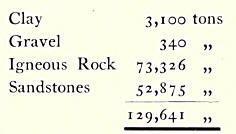|
Forfarshire cannot be
said to be rich in minerals, though it possesses quarries of
exceptionally fine building stone and paving stone. Certain older
writers, indeed, speak of mines and of veins of ore that seemed to
them to give promise of great things; but these expectations have
not been realised.
In the reign of James
V, Robert Seton writes, “Some report that at Clovo, at the head of
South Esk, some eight miles from Killiemuir, there is found gold and
silver.” And in his description of the county written in 1678,
Edward says: “As to the metals contained in the bowels of this
county it is affirmed that different kinds of them are to be found
in the valley of North Esk. The great-grandfather of the present
proprietor of Edzell discovered a mine of iron at the wood of Dalbog,
and built a smelting-house for preparing the metal. This gentleman’s
grandson found some lead ore near Innermark, which he refined. The
son of this latter found a very rich mine of lead on the banks of
the Mark, and about a mile up the valley from the castle of
Innermark. In a mountain of hard rock where eighteen miners are
digging deeper every day, they have come to a large vein of ore,
which, when the lead is extracted and properly refined, yields a
fifty-fourth part of silver. This vein seems to be inexhaustible.”
Elsewherewe read that Sir David Lindsay of Edzell in 1593 discovered
in Glen Esk two mines of copper.

But to pass from the
experiments and too often unfulfilled expectations of former days,
the latest Government returns of quarrying in Forfarshire will show
us the nature and the extent of modern operations. The figures are
:—

The making of bricks, a relatively
insignificant industry in the county, is carried on at Barry,
Montrose, and elsewhere. Whinstone and other igneous rocks are used
mainly for road-making, and are quarried all over the county. The
most important sandstone quarries are in the neighbourhood of Dundee
and Arbroath. Farther north many quarries have in recent years been
closed either because they are exhausted or cannot be profitably
worked, or because, in paving, concrete has largely superseded
stone.
The total output of
sandstone, quartzite, etc. in Scotland in 1910 was 743,189 tons; and
the following table shows the number of people employed in the chief
districts, the production in tons, and the values for the various
counties :—

From this it would appear that while the
output from the Forfarshire quarries is comparatively low, the value
per ton is relatively very high. Indeed Forfarshire building stone
and paving stone have long enjoyed a high reputation throughout the
country, and many important edifices public and private in
Edinburgh, Glasgow, Dundee, and other towns have been built of stone
obtained from Carmyllie, Leoch, Pitairlie, Duntrune, Wellbank,
West-hall, and other Forfarshire quarries.
The Forfarshire
stones are sandstones, varying in texture and in colour, as blue,
grey, pink, and red. |

